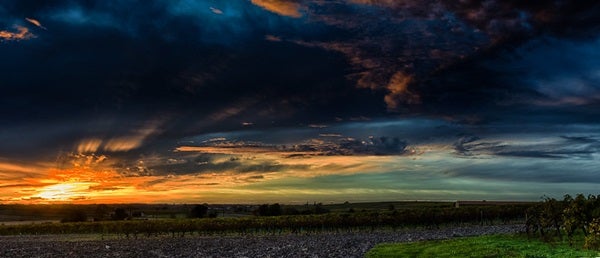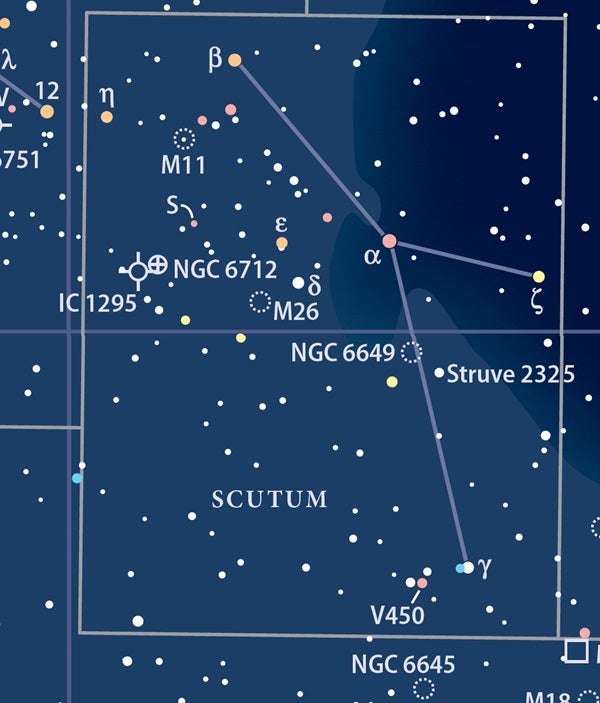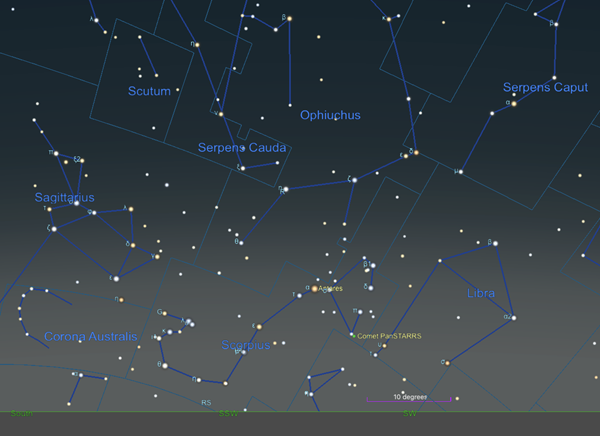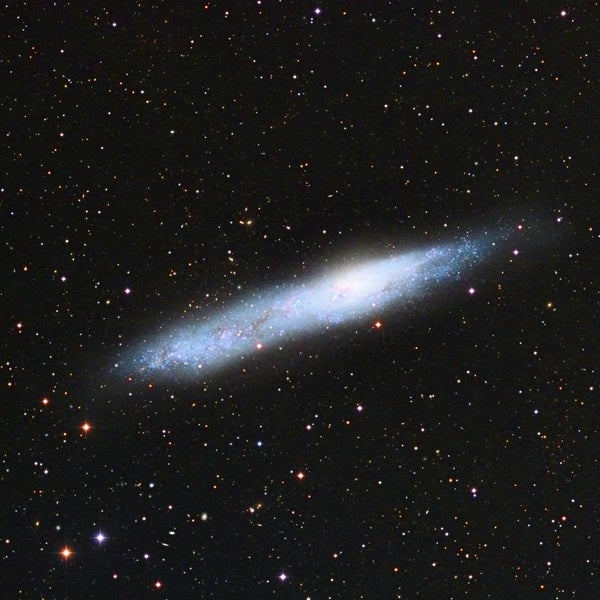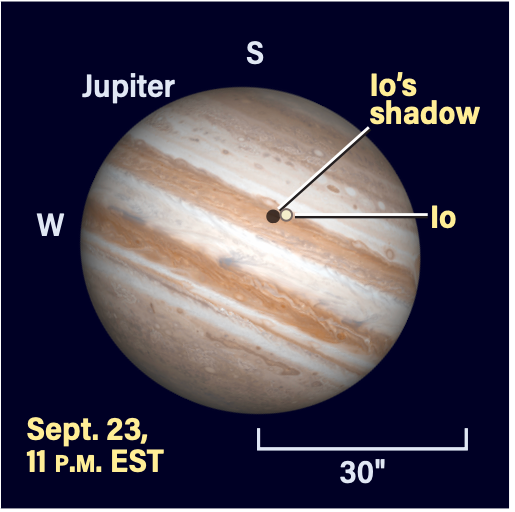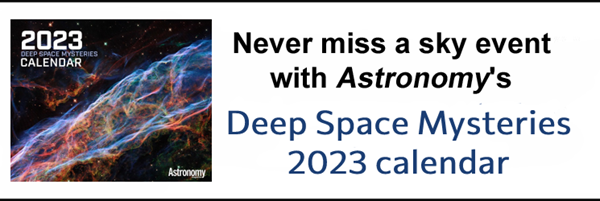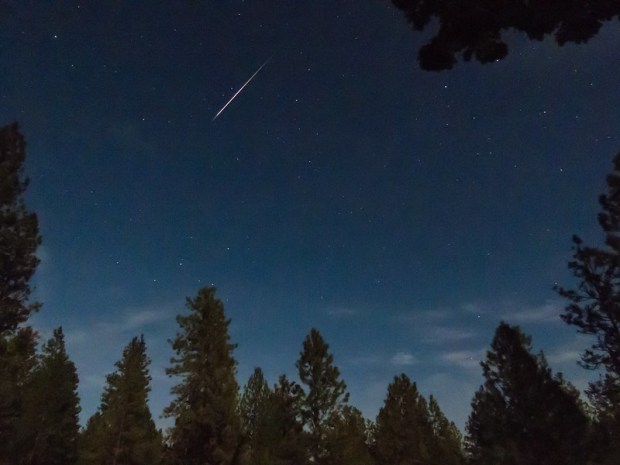Friday, September 16
The solar system’s most distant planet, Neptune, reaches opposition at 6 P.M. EDT. It’s located in far northeastern Aquarius, near the border of that constellation and nearby Pisces, where Jupiter sits. At magnitude 7.7, Neptune should be an easy binocular object — here’s how to find it.
The best time to look is late evening, when the sky is dark and Neptune has risen a decent amount above the horizon. Look east and locate the Circlet of Pisces, a seven-star asterism in western Pisces. The Circlet’s southeasternmost star is magnitude 4.5 Lambda (λ) Piscium. You’ll find Neptune’s 2″-wide disk just 5° due south of Lambda. To guide you further, there’s a zigzagging line of four 6th- to 7th-magnitude stars in the region, which form a shape similar to the “w” of Cassiopeia, albeit missing one star in the northwest. Find the easternmost star in this pattern, then look east until you hit a brighter magnitude 5.5 star. Neptune is halfway between these two stars.
You can also use Jupiter as a signpost to find Neptune — the bright, magnitude -2.9 planet is unmissable nearby in Pisces, 11° east-northeast of Neptune.
The Moon passes 4° north of Mars at 10 P.M. EDT, though neither are visible at that time. We’ll check them out tomorrow in the early-morning sky.
Sunrise: 6:42 A.M.
Sunset: 7:07 P.M.
Moonrise: 10:40 P.M.
Moonset: 1:23 P.M.
Moon Phase: Waning gibbous (62%)
*Times for sunrise, sunset, moonrise, and moonset are given in local time from 40° N 90° W. The Moon’s illumination is given at 12 P.M. local time from the same location.
Saturday, September 17
Early risers can catch the Moon and Mars hanging together in the predawn sky. An hour before sunrise, look southeast to find Mars 70° high and shining at magnitude –0.4 in Taurus. Don’t confuse it with slightly dimmer (magnitude 0.9) Aldebaran, a red giant star sitting amid the Hyades cluster sprinkled across the Bull’s nose. Mars sits about halfway between Aldebaran and the Moon, now 55 percent lit and fading quickly that last few percent toward Last Quarter. Our satellite will reach that Last Quarter phase this evening at 5:52 P.M. EDT.
Directly below Taurus in the sky right now is Orion the Hunter, recognizable thanks to his three-star belt. Another red giant star lurks in this constellation: magnitude 0.5 Betelgeuse, Orion’s right shoulder (left on the sky; the figure is generally drawn facing the observer). Below Orion is Canis Major the Big Dog, whose nose is marked by magnitude –1.4 Sirius, the brightest star in the sky.
Sunrise: 6:43 A.M.
Sunset: 7:05 P.M.
Moonrise: 11:23 P.M.
Moonset: 2:23 P.M.
Moon Phase: Waning gibbous (52%)
Sunday, September 18
With the Moon rising later and later, there’s a great dark-sky window this evening to explore the small constellation Scutum in the south. It’s located just southwest of 3rd-magnitude Lambda Aquilae, which marks Aquila’s tail.
If your horizon is clear and before the Moon rises, focus on this region; does it look like it contains more stars than its surroundings? Such features are typically called star clouds and are noticeable to the naked eye.
Zooming in, the main “figure” of the Shield is made of four stars: Alpha (α), Beta (β), Zeta (ζ), and Gamma (γ) Scuti. Scutum contains several deep-sky objects, including two Messier targets: M26 and M11, both open clusters. M26 is about 2.7° east-southeast of Alpha Scuti; this 8th-magnitude grouping of stars spans about 15′ and mostly looks like a small overdensity of stars. Much more impressive is M11, also called the Wild Duck Cluster. We visited this one last week; it’s a 6th-magnitude cluster spanning about 14′ and contains some 3,000 stars. You can find it 1.8° southeast of Beta Scuti, or 4° west-southwest of Lambda Aquilae.
Sunrise: 6:44 A.M.
Sunset: 7:04 P.M.
Moonrise: —
Moonset: 3:18 P.M.
Moon Phase: Waning crescent (43%)
Monday, September 19
The Moon reaches apogee, the farthest point from Earth in its orbit, at 10:43 A.M. EDT. At that time, our satellite will sit 251,396 miles (404,583 kilometers) away.
Comet C/2017 K2 (PanSTARRS) is now roughly 9th magnitude as it travels through Scorpius in the southwest. Tonight, the comet sits near 4th-magnitude Rho (ρ) Scorpii, less than 0.5° due west of the star. Start looking for it as soon as the stars start to pop out in the darkening sky — this region sets fairly early in the evening, so there’s not much time after sunset to observe it. You’ll likely be able to catch the comet in binoculars or a small scope as long as you have a clear view of the horizon, little light pollution, and a bit of patience.
Scorpius is one of the more easily recognized constellation, thanks to its deep red heart, Antares, and curving tail. Look to the Scorpion’s upper left (east) and you’ll find the famous Teapot asterism in Sagittarius. This is the direction of our galaxy’s center and the location of its supermassive black hole, Sagittarius A*.
Sunrise: 6:45 A.M.
Sunset: 7:02 P.M.
Moonrise: 12:13 A.M.
Moonset: 4:06 P.M.
Moon Phase: Waning crescent (33%)
Tuesday, September 20
If you have a small telescope and some time around midnight, tonight is the perfect night to hunt down the Southern Cigar Galaxy (NGC 55). Located in southern Sculptor, this 8th-magnitude galaxy is one of the sky’s brightest. But it lies close to the southern horizon for Northern Hemisphere observers, making it a bit tricky to spot. You’ll need a clear view of the horizon; an elevated observing site is even better.
Today, this region gets highest above the horizon around 1 A.M. — just before the Moon rises, so our satellite is conveniently out of sight. Look first for magnitude 2.4 Ankaa (Alpha Phoenicis) in Phoenix. The Southern Cigar lies just under 4° northwest of this star.
Take your time with this long, thin target, and you’ll notice that the galaxy’s bright core appears slightly offset from its center, to the west. In total, the galaxy measures some 30′ long (the same width as the Full Moon!) by 6.3′ wide. Use averted vision to see if you can pick out the dust lanes that split the galaxy’s arms.
Sunrise: 6:46 A.M.
Sunset: 7:00 P.M.
Moonrise: 1:09 A.M.
Moonset: 4:47 P.M.
Moon Phase: Waning crescent (25%)
Wednesday, September 21
Sometimes, it feels like the names astronomers give objects in the sky are a little off base. But other times, they’re spot on — and that’s the case with the planetary nebula popularly known as the Blue Snowball. Located in northern Andromeda, this compact shell of gas blown off by a dying star is also cataloged as NGC 7662.
You’ll want a larger scope to view this one — 8 inches or more — if you can swing it. To locate the Blue Snowball, look northeast after dark and find 4th-magnitude Iota (ι) Andromedae. The Blue Snowball is just over 2° west-southwest of this star, a little less than halfway between Iota and nearby Omicron (ο) Andromedae.
At just 2′ across, NGC 7662 is small enough that its magnitude 9 glow doesn’t get too spread out, providing a bright enough target to stimulate your eyes’ light-sensing cells, which is why it appears particularly blue. Just how blue, however, is in the eye of the beholder, so see what shade you think fits it best. If you’ve got observing buddies, compare your opinion with theirs — they might differ!
Sunrise: 6:47 A.M.
Sunset: 6:59 P.M.
Moonrise: 2:09 A.M.
Moonset: 5:23 P.M.
Moon Phase: Waning crescent (17%)
Thursday, September 22
Although the first day of meteorological autumn is September 1, the astronomical season doesn’t kick off until later in the month. The autumnal equinox occurs today at 9:04 P.M. EDT.
The equinox is the date when the Sun’s path passes directly above the equator, marking the beginning of autumn in the Northern Hemisphere (and spring in the Southern Hemisphere). You’ve likely noticed the Sun is starting to rise later and set earlier in preparation for longer winter nights — which, although cold, are excellent for lengthy observing sessions.
Tonight as the Sun is setting, the grand constellation Pegasus the Winged Horse is rising in the east. Pegasus is the seventh-largest constellation overall and the second largest of the autumn constellations, right behind Cetus the Whale. An hour or two after sunset, once the sky grows dark, see if you can find the Great Square of Pegasus sitting due east and drawn by connecting the stars Markab, Scheat, Algenib, and Alpheratz.
Within Pegasus sits an object that many consider autumn’s showpiece globular cluster: M15. It lies just 4° west-northwest of Enif, Pegasus’ nose star. Glowing at magnitude 6.2, binoculars or any small scope will show this 12′-wide ball of ancient stars; the higher the magnification, the more individual suns you’ll resolve.
Sunrise: 6:48 A.M.
Sunset: 6:57 P.M.
Moonrise: 3:12 A.M.
Moonset: 5:52 P.M.
Moon Phase: Waning crescent (10%)
Friday, September 23
Mercury reaches inferior conjunction at 3 A.M. EDT. It will reappear in the morning sky by early October.
Jupiter is nearing opposition in just three days, and it’s obvious if you’ve been tracking transits of its moons and shadows. Last Friday, Io and its shadow trekked across the face of the planet with a 15-minute separation between them. Tonight, the journey repeats starting just before 10 P.M. EDT, but with a difference: Now they’re separated by only 5 minutes and cross the disk so close to each other that they’re nearly overlapping. By 11 P.M. EDT, they’re perfectly placed roughly halfway across the disk. Both leave the western limb just over an hour later, with Io’s shadow slightly leading the bright spot of the moon.
Sunrise: 6:49 A.M.
Sunset: 6:55 P.M.
Moonrise: 4:15 A.M.
Moonset: 6:18 P.M.
Moon Phase: Waning crescent (5%)

